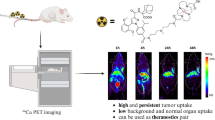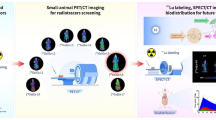Abstract
Purpose
Pharmacokinetic analyses estimate the mean concentration of drug within a given tissue as a function of time, but do not give information about the spatial distribution of drugs within that tissue. Here, we compare the time-dependent spatial distribution of three anticancer drugs within tumors, heart, kidney, liver and brain.
Methods
Mice bearing various xenografts were treated with doxorubicin, mitoxantrone or topotecan. At various times after injection, tumors and samples of heart, kidney, liver and brain were excised.
Results
Within solid tumors, the distribution of doxorubicin, mitoxantrone and topotecan was limited to perivascular regions at 10 min after administration and the distance from blood vessels at which drug intensity fell to half was ~25–75 μm. Although drug distribution improved after 3 and 24 h, there remained a significant decrease in drug fluorescence with increasing distance from tumor blood vessels. Drug distribution was relatively uniform in the heart, kidney and liver with substantially greater perivascular drug uptake than in tumors. There was significantly higher total drug fluorescence in the liver than in tumors after 10 min, 3 and 24 h. Little to no drug fluorescence was observed in the brain.
Conclusions
There are marked differences in the spatial distributions of three anticancer drugs within tumor tissue and normal tissues over time, with greater exposure to most normal tissues and limited drug distribution to many cells in tumors. Studies of the spatial distribution of drugs are required to complement pharmacokinetic data in order to better understand and predict drug effects and toxicities.






Similar content being viewed by others
References
Adamson PC, Zimm S, Ragab AH, Steinberg SM, Balis F, Kamen BA, Vietti TJ, Gillespie A, Poplack DG (1990) A phase II trial of continuous-infusion 6-mercaptopurine for childhood solid tumors. Cancer Chemother Pharmacol 26:343–344
Alberts DS, Peng YM, Bowden GT, Dalton WS, Mackel C (1985) Pharmacology of mitoxantrone: mode of action and pharmacokinetics. Invest New Drugs 3:101–107
Alberts DS, Peng YM, Leigh S, Davis TP, Woodward DL (1985) Disposition of mitoxantrone in cancer patients. Cancer Res 45:1879–1884
Benjamin LE, Golijanin D, Itin A, Pode D, Keshet E (1999) Selective ablation of immature blood vessels in established human tumors follows vascular endothelial growth factor withdrawal. J Clin Invest 103:159–165
Benjamin RS, Riggs CE Jr, Bachur NR (1977) Plasma pharmacokinetics of adriamycin and its metabolites in humans with normal hepatic and renal function. Cancer Res 37:1416–1420
Carmeliet P, Jain RK (2000) Angiogenesis in cancer and other diseases. Nature 407:249–257
Crawford AR, Lin XZ, Crawford JM (1998) The normal adult human liver biopsy: a quantitative reference standard. Hepatology 28:323–331
De Cesare M, Zunino F, Pace S, Pisano C, Pratesi G (2000) Efficacy and toxicity profile of oral topotecan in a panel of human tumour xenografts. Eur J Cancer 36:1558–1564
de Vries NA, Ouwehand M, Buckle T, Beijnen JH, van Tellingen O (2007) Determination of topotecan in human and mouse plasma and in mouse tissue homogenates by reversed-phase high-performance liquid chromatography. Biomed Chromatogr 21:1191–1200
Devalapally H, Rajan KS, Akkinepally RR, Devarakonda RK (2008) Safety, pharmacokinetics and biodistribution studies of a beta-galactoside prodrug of doxorubicin for improvement of tumor selective chemotherapy. Drug Dev Ind Pharm 34:789–795
Dorr RT (1996) Cytoprotective agents for anthracyclines. Semin Oncol 23:23–34
Faulds D, Balfour JA, Chrisp P, Langtry HD (1991) Mitoxantrone. A review of its pharmacodynamic and pharmacokinetic properties, and therapeutic potential in the chemotherapy of cancer. Drugs 41:400–449
Fujita H, Okamoto M, Takao A, Abe H, Ishii R, Takeda K (1995) Pharmacokinetics of SK and F 104864 in experimental animals. I. Plasma level. Gan To Kagaku Ryoho 22:1783–1787
Gewirtz DA (1999) A critical evaluation of the mechanisms of action proposed for the antitumor effects of the anthracycline antibiotics adriamycin and daunorubicin. Biochem Pharmacol 57:727–741
Gonzalez-Paz O, Polizzi D, De Cesare M, Zunino F, Bigioni M, Maggi CA, Manzini S, Pratesi G (2001) Tissue distribution, antitumour activity and in vivo apoptosis induction by MEN10755 in nude mice. Eur J Cancer 37:431–437
Gordon AN, Fleagle JT, Guthrie D, Parkin DE, Gore ME, Lacave AJ (2001) Recurrent epithelial ovarian carcinoma: a randomized phase III study of pegylated liposomal doxorubicin versus topotecan. J Clin Oncol 19:3312–3322
Grantab R, Sivananthan S, Tannock IF (2006) The penetration of anticancer drugs through tumor tissue as a function of cellular adhesion and packing density of tumor cells. Cancer Res 66:1033–1039
Greene RF, Collins JM, Jenkins JF, Speyer JL, Myers CE (1983) Plasma pharmacokinetics of adriamycin and adriamycinol: implications for the design of in vitro experiments and treatment protocols. Cancer Res 43:3417–3421
Gustafson DL, Rastatter JC, Colombo T, Long ME (2002) Doxorubicin pharmacokinetics: macromolecule binding, metabolism, and excretion in the context of a physiologic model. J Pharm Sci 91:1488–1501
Haas NB, LaCreta FP, Walczak J, Hudes GR, Brennan JM, Ozols RF, O’Dwyer PJ (1994) Phase I/pharmacokinetic study of topotecan by 24-hour continuous infusion weekly. Cancer Res 54:1220–1226
Hashizume H, Baluk P, Morikawa S, McLean JW, Thurston G, Roberge S, Jain RK, McDonald DM (2000) Openings between defective endothelial cells explain tumor vessel leakiness. Am J Pathol 156:1363–1380
Hortobagyi GN (1997) Anthracyclines in the treatment of cancer. An overview. Drugs 54(Suppl 4):1–7
Hsiang YH, Hertzberg R, Hecht S, Liu LF (1985) Camptothecin induces protein-linked DNA breaks via mammalian DNA topoisomerase I. J Biol Chem 260:14873–14878
Jain KK (2000) Evaluation of mitoxantrone for the treatment of multiple sclerosis. Expert Opin Investig Drugs 9:1139–1149
Jain RK (1988) Determinants of tumor blood flow: a review. Cancer Res 48:2641–2658
Jain RK (1994) Barriers to drug delivery in solid tumors. Sci Am 271:58–65
Jain RK (1996) Delivery of molecular medicine to solid tumors. Science 271:1079–1080
Johnson JL, Ahmad A, Khan S, Wang YF, Abu-Qare AW, Ayoub JE, Zhang A, Ahmad I (2004) Improved liquid chromatographic method for mitoxantrone quantification in mouse plasma and tissues to study the pharmacokinetics of a liposome entrapped mitoxantrone formulation. J Chromatogr B Analyt Technol Biomed Life Sci 799:149–155
Lankelma J, Dekker H, Luque FR, Luykx S, Hoekman K, van der Valk P, van Diest PJ, Pinedo HM (1999) Doxorubicin gradients in human breast cancer. Clin Cancer Res 5:1703–1707
Less JR, Skalak TC, Sevick EM, Jain RK (1991) Microvascular architecture in a mammary carcinoma: branching patterns and vessel dimensions. Cancer Res 51:265–273
Liu LF (1989) DNA topoisomerase poisons as antitumor drugs. Annu Rev Biochem 58:351–375
Milosevic MF, Fyles AW, Wong R, Pintilie M, Kavanagh MC, Levin W, Manchul LA, Keane TJ, Hill RP (1998) Interstitial fluid pressure in cervical carcinoma: within tumor heterogeneity, and relation to oxygen tension. Cancer 82:2418–2426
Nederman T, Carlsson J (1984) Penetration and binding of vinblastine and 5-fluorouracil in cellular spheroids. Cancer Chemother Pharmacol 13:131–135
Primeau AJ, Rendon A, Hedley D, Lilge L, Tannock IF (2005) The distribution of the anticancer drug Doxorubicin in relation to blood vessels in solid tumors. Clin Cancer Res 11:8782–8788
Rentsch KM, Horber DH, Schwendener RA, Wunderli-Allenspach H, Hanseler E (1997) Comparative pharmacokinetic and cytotoxic analysis of three different formulations of mitoxantrone in mice. Br J Cancer 75:986–992
Rowinsky EK, Grochow LB, Hendricks CB, Ettinger DS, Forastiere AA, Hurowitz LA, McGuire WP, Sartorius SE, Lubejko BG, Kaufmann SH et al (1992) Phase I and pharmacologic study of topotecan: a novel topoisomerase I inhibitor. J Clin Oncol 10:647–656
Sartiano GP, Lynch WE, Bullington WD (1979) Mechanism of action of the anthracycline anti-tumor antibiotics, doxorubicin, daunomycin and rubidazone: preferential inhibition of DNA polymerase alpha. J Antibiot (Tokyo) 32:1038–1045
Shenkenberg TD, Von Hoff DD (1986) Mitoxantrone: a new anticancer drug with significant clinical activity. Ann Intern Med 105:67–81
Tannock IF, Lee CM, Tunggal JK, Cowan DS, Egorin MJ (2002) Limited penetration of anticancer drugs through tumor tissue: a potential cause of resistance of solid tumors to chemotherapy. Clin Cancer Res 8:878–884
Tosoni A, Ermani M, Brandes AA (2004) The pathogenesis and treatment of brain metastases: a comprehensive review. Crit Rev Oncol Hematol 52:199–215
Tredan O, Garbens AB, Lalani AS, Tannock IF (2009) The hypoxia-activated ProDrug AQ4 N penetrates deeply in tumor tissues and complements the limited distribution of mitoxantrone. Cancer Res 69:940–947
Tunggal JK, Cowan DS, Shaikh H, Tannock IF (1999) Penetration of anticancer drugs through solid tissue: a factor that limits the effectiveness of chemotherapy for solid tumors. Clin Cancer Res 5:1583–1586
Urva SR, Shin BS, Yang VC, Balthasar JP (2009) Sensitive high performance liquid chromatographic assay for assessment of doxorubicin pharmacokinetics in mouse plasma and tissues. J Chromatogr B Analyt Technol Biomed Life Sci 877:837–841
von Pawel J, Schiller JH, Shepherd FA, Fields SZ, Kleisbauer JP, Chrysson NG, Stewart DJ, Clark PI, Palmer MC, Depierre A, Carmichael J, Krebs JB, Ross G, Lane SR, Gralla R (1999) Topotecan versus cyclophosphamide, doxorubicin, and vincristine for the treatment of recurrent small-cell lung cancer. J Clin Oncol 17:658–667
Weiss RB (1992) The anthracyclines: will we ever find a better doxorubicin? Semin Oncol 19:670–686
Wilkinson PM, Israel M, Pegg WJ, Frei E 3rd (1979) Comparative metabolism and excretion of adriamycin in man, monkey, and rat. Cancer Chemother Pharmacol 2:121–125
Young RC, Ozols RF, Myers CE (1981) The anthracycline antineoplastic drugs. N Engl J Med 305:139–153
Zheng JH, Chen CT, Au JL, Wientjes MG (2001) Time- and concentration-dependent penetration of doxorubicin in prostate tumors. AAPS PharmSci 3:E15
Acknowledgments
We would like to acknowledge the Pathology Research Program at Toronto General Hospital for providing support with immunohistochemical staining. This work was supported by a Grant from the Canadian Institute for Health Research.
Conflict of interest
None.
Author information
Authors and Affiliations
Corresponding author
Rights and permissions
About this article
Cite this article
Patel, K.J., Trédan, O. & Tannock, I.F. Distribution of the anticancer drugs doxorubicin, mitoxantrone and topotecan in tumors and normal tissues. Cancer Chemother Pharmacol 72, 127–138 (2013). https://doi.org/10.1007/s00280-013-2176-z
Received:
Accepted:
Published:
Issue Date:
DOI: https://doi.org/10.1007/s00280-013-2176-z




